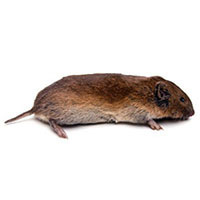Deer Mice in Wisconsin
The common name of the deer mouse comes from the coloration of the rodent, which resembles a white-tailed deer. Omnivorous and adaptable, deer mice tend to be opportunistic eaters when they inhabit homes and buildings. In nature, the rodents target various invertebrates, seeds, fruits, grains, fungi, flowers, and nuts. The deer mouse typically lives a year in the wild but can survive for two or three years in captivity. These rodents are a common problem in agricultural areas, and will sometimes look for shelter in homes over winter. Their true danger lies in the fact that they are common carriers of hantavirus.
Deer Mouse Habits
As nocturnal rodents, deer mice rarely leave their well-hidden nests during the day. They nest in burrows, rock crevices, brush piles, and tree holes. Nests are made with a soft, insulating material, including moss, dried grass, leaves, and feathers. A nest may be inhabited by a family of deer mice consisting of the parents and several young. Over the course of a year, a family of deer mice may utilize several nests, typically abandoning a nest after it has become fouled with feces and waste. During colder months deer mice seek shelter inside and enter buildings. They are excellent climbers and can be found in even upper levels of structures, including attics.
Deer Mouse Habits & Dangers
Throughout most of the year, deer mice nest in outdoor areas that are quiet, dark, and undisturbed. When the weather gets colder during winter, deer mice tend to invade homes, garages, sheds, and sometimes even vehicles. When they get indoors, they are often found in basements or attics. Deer mice can leave greasy stains (sebum) on walls, windows, and other surfaces. The biggest threat of deer mice is that they are able to transmit the dangerous—and potentially fatal—hantavirus. This disease is often transmitted through contact with mouse carcasses, or by breathing in air-borne urine droplets from infected deer mice.
If you have a deer mouse infestation in your Wisconsin property, contact your local rodent control experts!
Need help with Deer Mice?
We'll call you! Leave your information below.
Pests Belong Outside!
Leave your information below and we will give you a call back.
"*" indicates required fields
*During normal business hours. After hours inquiries will be returned the next business day.




